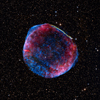CXC Home | Search | Help | Image Use Policy | Latest Images | Privacy | Accessibility | Glossary | Q&A
Tour of SN 1006
Quicktime MPEG
Over a thousand years ago, a new object was spotted in the sky that was brighter than Venus and visible during the day for weeks. This spectacular lightshow was documented in China, Japan, Europe and the Arab world, and we now know it was the brightest supernova ever recorded on Earth. By using modern telescopes that detect optical, radio and x-ray light, astronomers can continue to study the expanding debris field. The original star was actually one of a pair. One star pulled so much material from its companion, that eventually it triggered an explosion that destroyed it. What remains is this complicated and beautiful structure which astronomers call Supernova 1006. This helps us better understand how some stars explode.
[Runtime: 0.45]
Quicktime MPEG
Over a thousand years ago, a new object was spotted in the sky that was brighter than Venus and visible during the day for weeks. This spectacular lightshow was documented in China, Japan, Europe and the Arab world, and we now know it was the brightest supernova ever recorded on Earth. By using modern telescopes that detect optical, radio and x-ray light, astronomers can continue to study the expanding debris field. The original star was actually one of a pair. One star pulled so much material from its companion, that eventually it triggered an explosion that destroyed it. What remains is this complicated and beautiful structure which astronomers call Supernova 1006. This helps us better understand how some stars explode.
[Runtime: 0.45]
(Credit: X-ray: NASA/CXC/Rutgers/G.Cassam-Chenaï, J.Hughes et al.; Radio: NRAO/AUI/NSF/GBT/VLA/Dyer, Maddalena & Cornwell; Optical: Middlebury College/F.Winkler, NOAO/AURA/NSF/CTIO Schmidt & DSS))
Return to SN 1006 (July 01, 2008)



